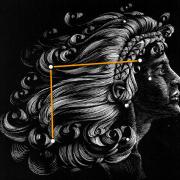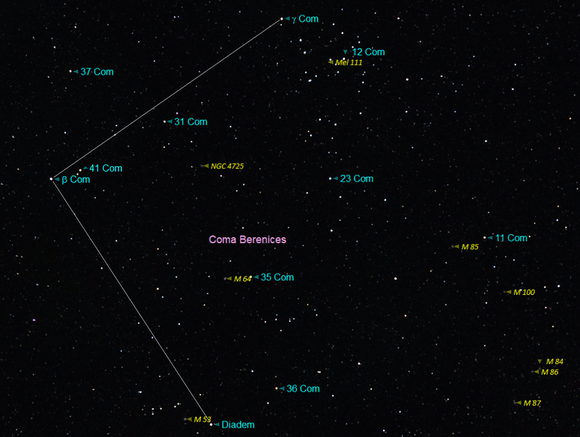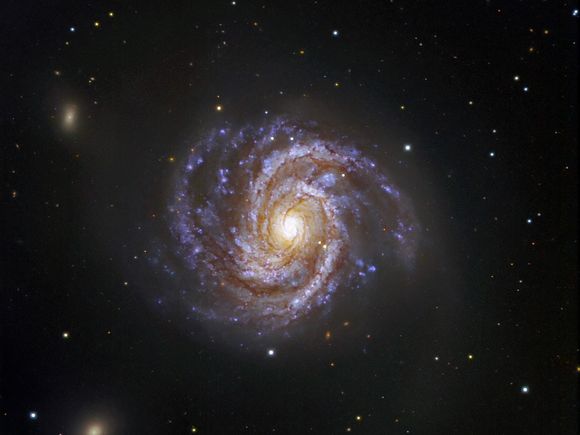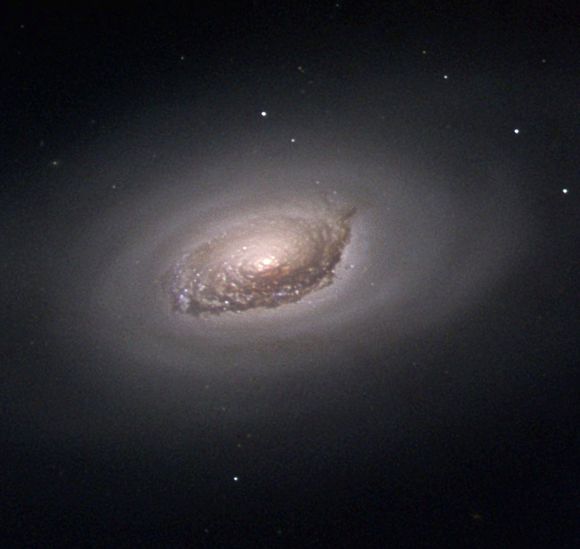Although Coma Berenices consists of just a smattering of ‘naked eye’ stars, it is one of the original 48 constellations, said to represent the amber tresses of Queen Berenices II.
She was both sister and wife of King Ptolemy III of ancient Egypt 245BC. Berenices vowed to cut off her beautiful hair, dedicating the tresses to the goddess Aphrodite, to ensure the safe return of her husband from the third Assyrian war. The King was victorious and the Queen duly kept her promise, placing the tresses in the temple of Aphorodite, from which they disappeared soon afterwards, according to the court astronomer, Conon, removed by Aphrodite herself, honouring the donor by placing them in the sky.
To the naked eye, Coma may be rather inconspicuous: just 3 main stars Alpha, Beta and Gamma of which Beta at +4.2 is the brightest, however it is a rewarding constellation to explore with many pleasing cascades of fainter stars visible in a telescope or pair of binoculars. Coma also contains numerous deep sky objects, more than its fair share for a relatively obscure group. Apart from containing the North Galactic Pole and the rich Coma galaxy cluster, part of the Coma Super cluster, the group also contains one open cluster (Mel 111) and 8 Messier objects. Coma is home to the northern part of the Virgo galaxy cluster including 6 Messier galaxies; M85, M88, M91, M98, M99 and M100. Two further Messier objects lie in Coma; the Galaxy M64 and the globular cluster M53.
Of the cluster galaxies, M85 (NGC 4382), is one of the cluster's brighter members at magnitude +9. M85 is classed as a spindle galaxy. It appears to have a counter - rotational central region compared to the rest of the galaxy. It appears the galaxy is interacting with several galaxies. It lies 48 million light years away and is some 99 thousand light years in diameter. Messier discovered it in 1781.
M88 (NGC 4501) is a multi-arm spiral galaxy seen somewhat edge-on. It has a highly-regular shape with well-developed, symmetrical arms and was among the first galaxies recognized as spiral. It lies 57 million light years away and is some 117,000 light years in diameter. M88 was discovered by Messier in March 1781.
M91 (NGC 4548), is a barred spiral galaxy with a bright, diffuse nucleus, but is one of the fainter objects in Messiers catalogue at magnitude 10.2. It lies 53 million light years away and is 83 thousand light years in diameter. Regarded as one of the missing Messier objects, he noted it in March 1781, but made a mistake in its position.
M98 (NGC 4192), is an elongated spiral galaxy seen nearly edge-on, but appears elliptical because of its unusual angle. It lies 44 million light years away and is over 125,000 light years in diameter.
M99 (NGC 4254) is a face-on spiral galaxy. Like M98 it is of magnitude-10 and has an unusually long arm on its west side. The galaxy lies 53 million light years away. It is 83,000 light years in diameter.
M100 (NGC 4321), is a magnitude-nine spiral galaxy seen face-on and one of the cluster's brightest. It possesses two prominent spiral arms and an array of secondary arms, as well as several dust lanes. It lies 49 million light years away and is some 108,000 light years in diameter.
M64 (NGC 4826) is known as the Black Eye Galaxy, because of the prominent dark dust lane in front of the galaxy's bright nucleus. Messier came across the galaxy in 1780 not knowing it had been observed by Edward Pigott and then Johann Bode a year earlier. This 60,000 diameter spiral is located about 19 million light-years away. Recent studies indicate that the interstellar gas in the galaxy's outer regions rotates in the opposite direction from that in the inner regions, leading astronomers to believe that several satellite galaxies have collided with it less than a billion years ago.
M53 (NGC 5024) is a globular cluster first noted by Johann Elert Bode in 1775 and independently discovered noted by Messier in February 1777. William Herchell was the first to resolve it into stars. The magnitude +7.7 cluster is around 60,000 light-years from Earth and is some 230 light years in diameter making it larger than the great M13 in Hercules. M53 has a mass equivalent to 750,000 solar masses.
Pick a fine moonless night in May and seek out the amber tresses of Berenices, a constellation hiding rather more than you think, certainly one warranting a ‘deeper comb’.
- Log in to post comments




